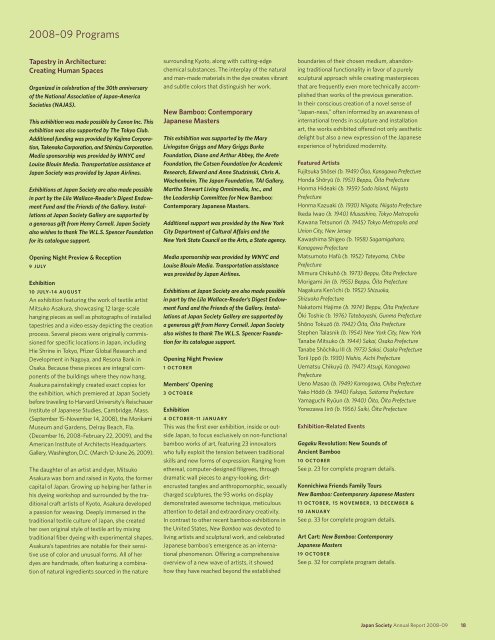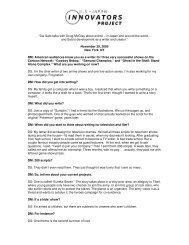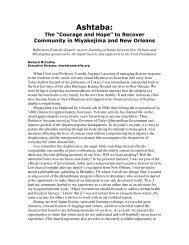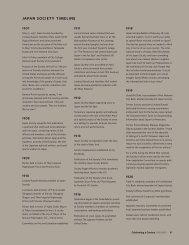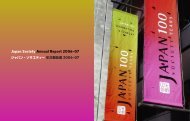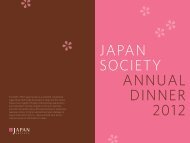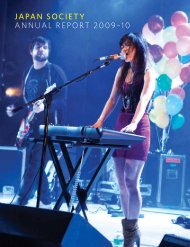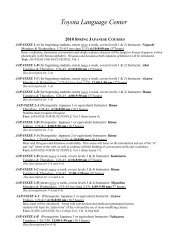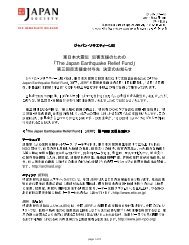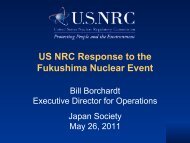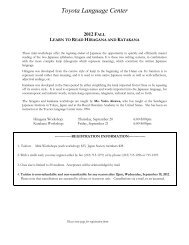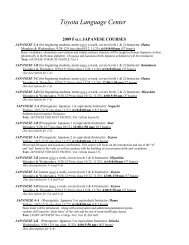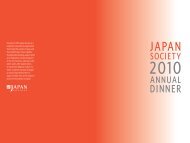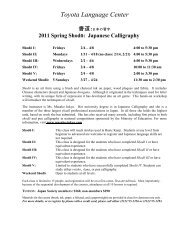Programs (PDF) - Japan Society Annual Report 2008â09 1
Programs (PDF) - Japan Society Annual Report 2008â09 1
Programs (PDF) - Japan Society Annual Report 2008â09 1
You also want an ePaper? Increase the reach of your titles
YUMPU automatically turns print PDFs into web optimized ePapers that Google loves.
2008–09 <strong>Programs</strong><br />
Tapestry in Architecture:<br />
Creating Human Spaces<br />
Organized in celebration of the 30th anniversary<br />
of the National Association of <strong>Japan</strong>-America<br />
Societies (NAJAS).<br />
This exhibition was made possible by Canon Inc. This<br />
exhibition was also supported by The Tokyo Club.<br />
Additional funding was provided by Kajima Corporation,<br />
Takenaka Corporation, and Shimizu Corporation.<br />
Media sponsorship was provided by WNYC and<br />
Louise Blouin Media. Transportation assistance at<br />
<strong>Japan</strong> <strong>Society</strong> was provided by <strong>Japan</strong> Airlines.<br />
Exhibitions at <strong>Japan</strong> <strong>Society</strong> are also made possible<br />
in part by the Lila Wallace-Reader’s Digest Endowment<br />
Fund and the Friends of the Gallery. Installations<br />
at <strong>Japan</strong> <strong>Society</strong> Gallery are supported by<br />
a generous gift from Henry Cornell. <strong>Japan</strong> <strong>Society</strong><br />
also wishes to thank The W.L.S. Spencer Foundation<br />
for its catalogue support.<br />
Opening Night Preview & Reception<br />
9 July<br />
Exhibition<br />
10 July–14 August<br />
An exhibition featuring the work of textile artist<br />
Mitsuko Asakura, showcasing 12 large-scale<br />
hanging pieces as well as photographs of installed<br />
tapestries and a video essay depicting the creation<br />
process. Several pieces were originally commissioned<br />
for specific locations in <strong>Japan</strong>, including<br />
Hie Shrine in Tokyo, Pfizer Global Research and<br />
Development in Nagoya, and Resona Bank in<br />
Osaka. Because these pieces are integral components<br />
of the buildings where they now hang,<br />
Asakura painstakingly created exact copies for<br />
the exhibition, which premiered at <strong>Japan</strong> <strong>Society</strong><br />
before traveling to Harvard University’s Reischauer<br />
Institute of <strong>Japan</strong>ese Studies, Cambridge, Mass.<br />
(September 15–November 14, 2008), the Morikami<br />
Museum and Gardens, Delray Beach, Fla.<br />
(December 16, 2008–February 22, 2009), and the<br />
American Institute of Architects Headquarters<br />
Gallery, Washington, D.C. (March 12–June 26, 2009).<br />
The daughter of an artist and dyer, Mitsuko<br />
Asakura was born and raised in Kyoto, the former<br />
capital of <strong>Japan</strong>. Growing up helping her father in<br />
his dyeing workshop and surrounded by the traditional<br />
craft artists of Kyoto, Asakura developed<br />
a passion for weaving. Deeply immersed in the<br />
traditional textile culture of <strong>Japan</strong>, she created<br />
her own original style of textile art by mixing<br />
traditional fiber dyeing with experimental shapes.<br />
Asakura’s tapestries are notable for their sensitive<br />
use of color and unusual forms. All of her<br />
dyes are handmade, often featuring a combination<br />
of natural ingredients sourced in the nature<br />
surrounding Kyoto, along with cutting-edge<br />
chemical substances. The interplay of the natural<br />
and man-made materials in the dye creates vibrant<br />
and subtle colors that distinguish her work.<br />
New Bamboo: Contemporary<br />
<strong>Japan</strong>ese Masters<br />
This exhibition was supported by the Mary<br />
Livingston Griggs and Mary Griggs Burke<br />
Foundation, Diane and Arthur Abbey, the Arete<br />
Foundation, the Cotsen Foundation for Academic<br />
Research, Edward and Anne Studzinski, Chris A.<br />
Wachenheim, The <strong>Japan</strong> Foundation, TAI Gallery,<br />
Martha Stewart Living Omnimedia, Inc., and<br />
the Leadership Committee for New Bamboo:<br />
Contemporary <strong>Japan</strong>ese Masters.<br />
Additional support was provided by the New York<br />
City Department of Cultural Affairs and the<br />
New York State Council on the Arts, a State agency.<br />
Media sponsorship was provided by WNYC and<br />
Louise Blouin Media. Transportation assistance<br />
was provided by <strong>Japan</strong> Airlines.<br />
Exhibitions at <strong>Japan</strong> <strong>Society</strong> are also made possible<br />
in part by the Lila Wallace-Reader’s Digest Endowment<br />
Fund and the Friends of the Gallery. Installations<br />
at <strong>Japan</strong> <strong>Society</strong> Gallery are supported by<br />
a generous gift from Henry Cornell. <strong>Japan</strong> <strong>Society</strong><br />
also wishes to thank The W.L.S. Spencer Foundation<br />
for its catalogue support.<br />
Opening Night Preview<br />
1 October<br />
Members’ Opening<br />
3 October<br />
Exhibition<br />
4 October–11 January<br />
This was the first ever exhibition, inside or outside<br />
<strong>Japan</strong>, to focus exclusively on non-functional<br />
bamboo works of art, featuring 23 innovators<br />
who fully exploit the tension between traditional<br />
skills and new forms of expression. Ranging from<br />
ethereal, computer-designed filigrees, through<br />
dramatic wall pieces to angry-looking, dirtencrusted<br />
tangles and anthropomorphic, sexually<br />
charged sculptures, the 93 works on display<br />
demonstrated awesome technique, meticulous<br />
attention to detail and extraordinary creativity.<br />
In contrast to other recent bamboo exhibitions in<br />
the United States, New Bamboo was devoted to<br />
living artists and sculptural work, and celebrated<br />
<strong>Japan</strong>ese bamboo’s emergence as an international<br />
phenomenon. Offering a comprehensive<br />
overview of a new wave of artists, it showed<br />
how they have reached beyond the established<br />
boundaries of their chosen medium, abandoning<br />
traditional functionality in favor of a purely<br />
sculptural approach while creating masterpieces<br />
that are frequently even more technically accomplished<br />
than works of the previous generation.<br />
In their conscious creation of a novel sense of<br />
“<strong>Japan</strong>-ness,” often informed by an awareness of<br />
international trends in sculpture and installation<br />
art, the works exhibited offered not only aesthetic<br />
delight but also a new expression of the <strong>Japan</strong>ese<br />
experience of hybridized modernity.<br />
Featured Artists<br />
Fujitsuka Shōsei (b. 1949) Ōiso, Kanagawa Prefecture<br />
Honda Shōryū (b. 1951) Beppu, Ōita Prefecture<br />
Honma Hideaki (b. 1959) Sado Island, Niigata<br />
Prefecture<br />
Honma Kazuaki (b. 1930) Niigata, Niigata Prefecture<br />
Ikeda Iwao (b. 1940) Musashino, Tokyo Metropolis<br />
Kawana Tetsunori (b. 1945) Tokyo Metropolis and<br />
Union City, New Jersey<br />
Kawashima Shigeo (b. 1958) Sagamigahara,<br />
Kanagawa Prefecture<br />
Matsumoto Hafū (b. 1952) Tateyama, Chiba<br />
Prefecture<br />
Mimura Chikuhō (b. 1973) Beppu, Ōita Prefecture<br />
Morigami Jin (b. 1955) Beppu, Ōita Prefecture<br />
Nagakura Ken’ichi (b. 1952) Shizuoka,<br />
Shizuoka Prefecture<br />
Nakatomi Hajime (b. 1974) Beppu, Ōita Prefecture<br />
Ōki Toshie (b. 1976) Tatebayashi, Gunma Prefecture<br />
Shōno Tokuzō (b. 1942) Ōita, Ōita Prefecture<br />
Stephen Talasnik (b. 1954) New York City, New York<br />
Tanabe Mitsuko (b. 1944) Sakai, Osaka Prefecture<br />
Tanabe Shōchiku III (b. 1973) Sakai, Osaka Prefecture<br />
Torii Ippō (b. 1930) Nishio, Aichi Prefecture<br />
Uematsu Chikuyū (b. 1947) Atsugi, Kanagawa<br />
Prefecture<br />
Ueno Masao (b. 1949) Kamogawa, Chiba Prefecture<br />
Yako Hōdō (b. 1940) Fukaya, Saitama Prefecture<br />
Yamaguchi Ryūun (b. 1940) Ōita, Ōita Prefecture<br />
Yonezawa Jirō (b. 1956) Saiki, Ōita Prefecture<br />
Exhibition-Related Events<br />
Gagaku Revolution: New Sounds of<br />
Ancient Bamboo<br />
10 October<br />
See p. 23 for complete program details.<br />
Konnichiwa Friends Family Tours<br />
New Bamboo: Contemporary <strong>Japan</strong>ese Masters<br />
1 1 O c to b e r , 1 5 N ov e m b e r , 1 3 D e c e m b e r &<br />
10 January<br />
See p. 33 for complete program details.<br />
Art Cart: New Bamboo: Contemporary<br />
<strong>Japan</strong>ese Masters<br />
19 October<br />
See p. 32 for complete program details.<br />
<strong>Japan</strong> <strong>Society</strong> <strong>Annual</strong> <strong>Report</strong> 2008–09 18


